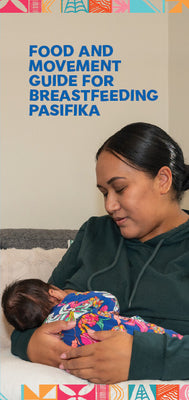Food and movement guide for breastfeeding Pasifika HE2651

Food information for Pacific breastfeeding women. Includes what to eat while breastfeeding, iodine, vitamin D, food allergies, alcohol, and daily activity.
To print on A4, please download the "spreads" file.
The full resource:
BREAST MILK IS PERFECTLY DESIGNED FOR YOUR BABY
Breast milk is more than just food. It is a way to connect with our ancestors, passing on
nourishment to make future generations healthy and strong.
It protects your baby against many common sicknesses and is the only food they need until they are 6 months old.
It is beneficial for you and baby to continue to breastfeed when they start to eat food, for up to two years or longer.
I was supported by my family to breastfeed because it boosts my girl’s immunity, so she gets sick less.
I wanted to breastfeed as it’s convenient. It was difficult at the start, but got easier with practice.
WHAT TO EAT WHILE BREASTFEEDING
Every food has a different job in our body. Nourish your body with a variety of health
and protective foods, building foods and energy foods.
Health and Protective Foods
Include fresh, frozen or canned vegetables and fruit. They have fibre, minerals and vitamins which help fight off sickness and can relieve constipation.
GREEN
Folate – to help your body make new cells
ORANGE
Vitamin A – to help your eyesight
RED
Lycopene – to help keep your heart strong
PURPLE & BLUE
Anti-oxidants – for your brain
YELLOW
Vitamin C – to help heal your body
Building Foods
Are meat, fish, and dairy foods. They have protein, iron and calcium to help with recovery from birth.
IRON
For immunity and energy
PROTEIN
For growth and repair
CALCIUM
For strong teeth and bones
Energy Foods
Give your body carbohydrates so you have energy to feed your baby and do everything that you need and love to do.
- All breastfeeding women need to take an iodine tablet every day to help baby’s brain develop.
- Alcohol is passed into breast milk so it’s safest not to drink. For more information, visit Feed Safe
- Vitamin D is needed for strong bones and teeth. The main source is sunlight, so aim to go for a walk outside every day.
- Aim to drink 10 cups of fluids daily. Water and low-fat milk are the best choice.
- Eating a variety of foods including bitter vegetables (like taro leaf) can help your baby learn to like the taste through your breast milk.
- If you do not have a food allergy, you do not need to avoid foods associated with allergies like milk, eggs, and wheat.
Snack ideas
- Cheese and tomato on toast
- Crackers and cheese
- Tuna sandwich and yoghurt
- Celery and peanut butter
- Porridge with banana
- Almonds
GETTING BACK INTO MOVEMENT
It is important to let your body recover after birth. When you are ready, daily movement will improve your sleep, give you more strength and energy and help you manage stress.
I started walking with other mums. The talanoa and fresh air lifted my spirits.
Dancing with my baby made me feel more energised.
I did some YouTube yoga videos and it helped me recover from labour and feel stronger.
EMOTIONAL HEALTH
It is normal to feel a bit down or stressed at times with a new baby, but sometimes
we need to seek extra support. You can talk to a trained counsellor at any time by free
calling or texting 1737.
BREASTFEEDING SUPPORT
- Your family is your biggest support. Make a plan with them to help with housework, so you can focus on feeding baby.
- Talk with your Midwife about Pacific breastfeeding support in your area
- The Mama Aroha healthify.nz/apps/m/mama-aroha-app/ and BreastfedNZ
healthify.nz/apps/b/breastfed-nz-app/ apps have lots of useful information
Māmā Aroha - Google Play Store
Māmā Aroha - App Store (apple.com)
BreastFedNZ - Google Play Store
BreastFedNZ - App Store (apple.com)
- Sign up to find a local breastfeeding group via La Leche League
- Call Plunketline - 0800 933 922
Available 24 hours a day, seven days a week
Created by The Cause Collective in consultation with the Pacific community.